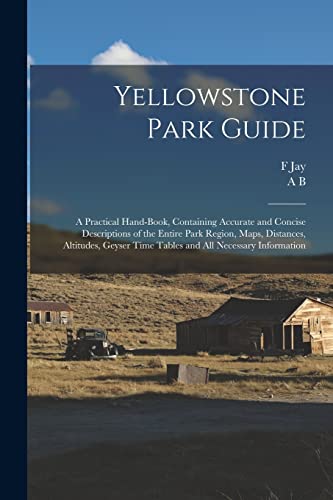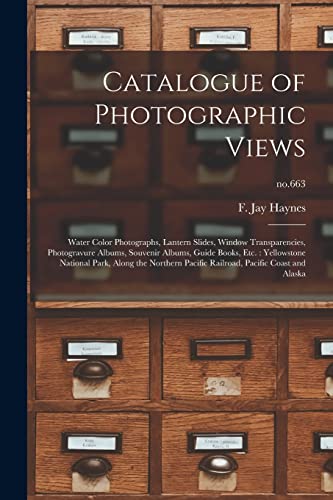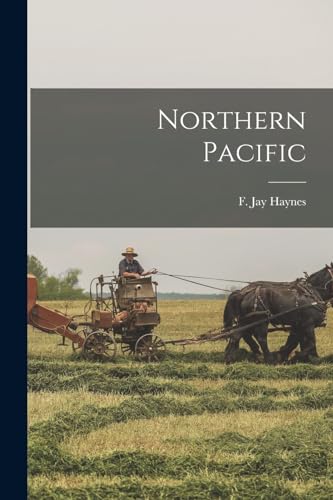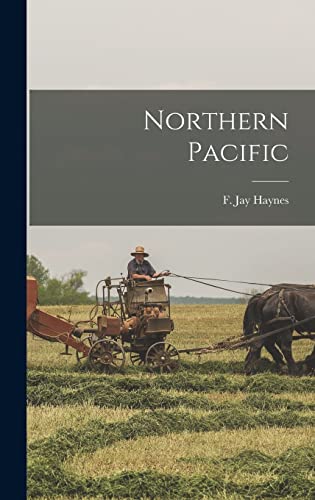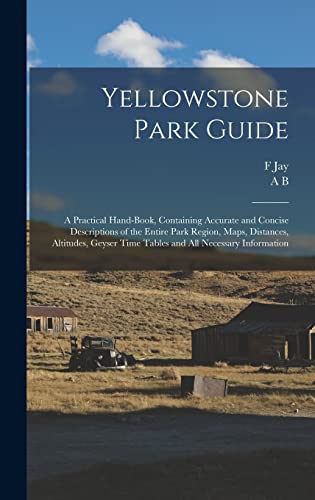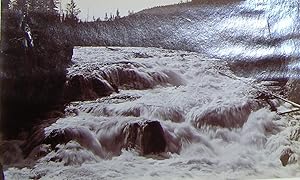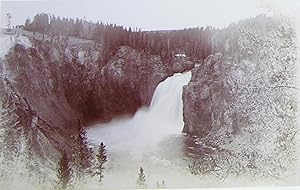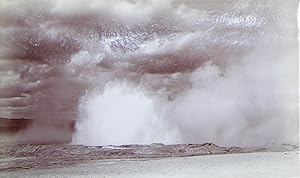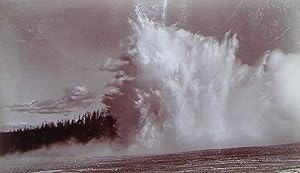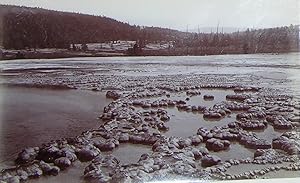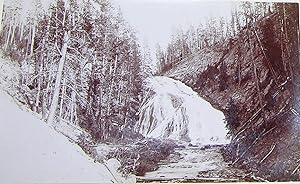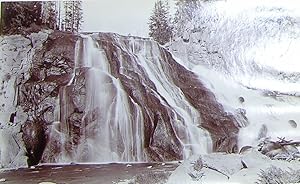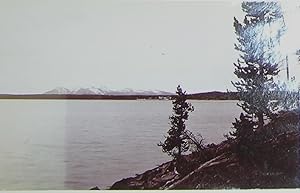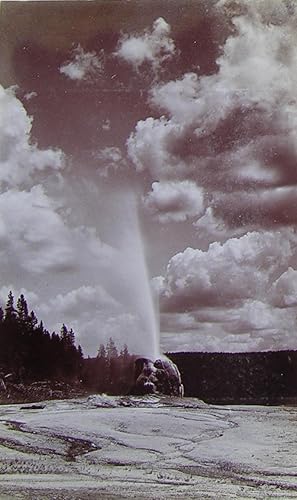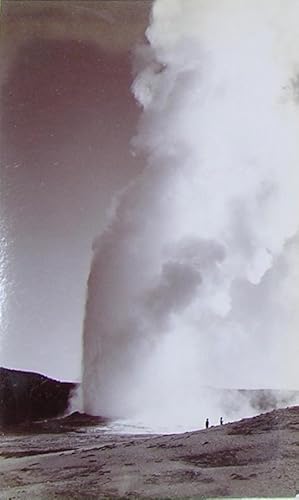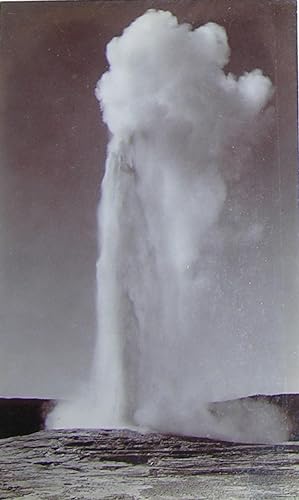Haynes Jay 1853 1921 (39 results)
Product Type
- All Product Types
- Books (39)
- Magazines & Periodicals
- Comics
- Sheet Music
- Art, Prints & Posters
- Photographs
- Maps
-
Manuscripts &
Paper Collectibles
Condition
Binding
Collectible Attributes
- First Edition (1)
- Signed
- Dust Jacket
- Seller-Supplied Images (12)
- Not Printed On Demand (31)
Free Shipping
Seller Location
Seller Rating
-
Haynes Souvenir Album Yellowstone Park
Published by Hardpress Publishing, 2013
ISBN 10: 1314494392ISBN 13: 9781314494396
Seller: PBShop.store US, Wood Dale, IL, U.S.A.
Book
PAP. Condition: New. New Book. Shipped from UK. Established seller since 2000.
More buying choices from other sellers on AbeBooks
New offers from £ 13.36
-
To Geyserland
Published by LEGARE STREET PR, 2022
ISBN 10: 1016521472ISBN 13: 9781016521475
Seller: PBShop.store US, Wood Dale, IL, U.S.A.
Book Print on Demand
PAP. Condition: New. New Book. Shipped from UK. THIS BOOK IS PRINTED ON DEMAND. Established seller since 2000.
More buying choices from other sellers on AbeBooks
New offers from £ 15.73
-
Yellowstone Park Guide; a Practical Hand-book, Containing Accurate and Concise Descriptions of the Entire Park Region, Maps, Distances, Altitudes, Gey
Published by Legare Street Press, 2022
ISBN 10: 101622883XISBN 13: 9781016228831
Seller: GreatBookPrices, Columbia, MD, U.S.A.
Book
Condition: As New. Unread book in perfect condition.
More buying choices from other sellers on AbeBooks
New offers from £ 16.06
Used offers from £ 14.07
Also find Softcover
-
Catalogue of Photographic Views: Water Color Photographs, Lantern Slides, Window Transparencies, Photogravure Albums, Souvenir Albums, Guide Books, Etc.: Yellowstone National Park, Along the Northern Pacific Railroad, Pacific Coast and Alaska; no.663
Published by Legare Street Press, 2021
ISBN 10: 101357690XISBN 13: 9781013576904
Seller: THE SAINT BOOKSTORE, Southport, United Kingdom
Book Print on Demand
Paperback / softback. Condition: New. This item is printed on demand. New copy - Usually dispatched within 5-9 working days.
-
Northern Pacific
Published by Legare Street Press, 2022
ISBN 10: 1017047065ISBN 13: 9781017047066
Seller: THE SAINT BOOKSTORE, Southport, United Kingdom
Book Print on Demand
Paperback / softback. Condition: New. This item is printed on demand. New copy - Usually dispatched within 5-9 working days.
-
Haynes Souvenir Album: Yellowstone Park (Hardback or Cased Book)
Published by Wentworth Press 8/29/2016, 2016
ISBN 10: 1374483885ISBN 13: 9781374483880
Seller: BargainBookStores, Grand Rapids, MI, U.S.A.
Book
Hardback or Cased Book. Condition: New. Haynes Souvenir Album: Yellowstone Park 0.56. Book.
-
Northern Pacific
Published by Legare Street Press, 2022
ISBN 10: 1017041954ISBN 13: 9781017041958
Seller: THE SAINT BOOKSTORE, Southport, United Kingdom
Book Print on Demand
Hardback. Condition: New. This item is printed on demand. New copy - Usually dispatched within 5-9 working days.
-
Yellowstone Park Guide; a Practical Hand-book, Containing Accurate and Concise Descriptions of the Entire Park Region, Maps, Distances, Altitudes, Geyser Time Tables and all Necessary Information
Published by Legare Street Press, 2022
ISBN 10: 1016223471ISBN 13: 9781016223478
Seller: THE SAINT BOOKSTORE, Southport, United Kingdom
Book Print on Demand
Hardback. Condition: New. This item is printed on demand. New copy - Usually dispatched within 5-9 working days.
-
To Geyserland: Union Pacific-Oregon Short Line Railroads to the Yellowstone National Park
Published by LIGHTNING SOURCE INC, 2015
ISBN 10: 1341176975ISBN 13: 9781341176975
Seller: Buchpark, Trebbin, Germany
Book
Condition: Sehr gut. Zustand: Sehr gut - Gepflegter, sauberer Zustand. | Seiten: 50.
-
PHOTOGRAPHED AND PUBLISHED BY F. JAY HAYNES, ST. PAUL, MINN. BRANCH STUDIO YELLOWSTONE PARK 1893
Published by F. Jay Haynes, Yellowstone Park, 1893
Seller: T. W. Palmer Books, Eugene, OR, U.S.A.
Book First Edition
Hardcover. Condition: Very Good. No Jacket. 1st Edition. 19 x 14 cm, 21 pages in one long folding series, averaging about four photographs per page, all fine except for two facing pictures that became stuck together and tore, inside lining of spine disintegrated, light gray cloth over boards with blue, brown and black picture on front and blind stamping on back. This fragile souvenir item is extremely rare and presents many interesting pictures of Yellowstone in 1893 when it was copyrighted.
-
Fine Photograph of "Cascades of the Firehole"
Published by [1887]., 1887
Seller: Arader Galleries - AraderNYC, New York, NY, U.S.A.
Fine albumen print, mounted on archival matt (5 x 8 inches; 11 x 14 inches), of the Cascades of the Firehole, number 19 pencilled lower left-hand corner of the matt. Provenance: from the library of William E. Hofman, his sale Christie's 3rd December, 2010, lot 343 A magnificent view of the the Cascades of the Firehole in Yellowstone National Park by the park's official photographer Frank Jay Haynes. This popular series of cascades is located at the head of Firehole Canyon just below an island which was used by Yellowstone's earliest visitors as a camping spot. Yellowstone, was the world's first national park, and "is situated mainly in Wyoming and extends into Montana and Idaho. It was established in 1872 by Congress, primarily because of its geysers, but also because of its remarkable assemblage of wildlife and unusual natural features. The "national park idea" pioneered at Yellowstone eventually spread worldwide. In the United States, Mackinac Island National Park (now a Michigan state park) was established in 1875 and Sequoia and Yosemite National Parks in 1890. (Yosemite had been a California state park since 1864.) Yellowstone remains the "mother park" in the U.S. national park system, which by the 1990s included 376 sites. The celebrated photographer Haynes was first hired as the official photographer of the Northern Pacific Railroad and "given his own travelling studio in a converted rail car, Haynes produced numerous famous images of the railroad's construction projects and of sites along its route. He held that position for nearly three decades. He also was appointed in 1884 as Yellowston's official photographer and sold materials from a store in the park itself. He retired in 1916. His images of Yellowstone are among his more important and dramatic imagery" (see Dorothy Sloan, Western Americana,10/18/2006, lot 254). "Boasting about three-quarters of the world's geysers (of which Old Faithful is the most famous) and over half of the thermal features, it also has one of the globe's most spectacular canyons, one of North America's most celebrated waterfalls, and more than 225 permanent waterfalls higher than fifteen feet. It has the premier wildlife sanctuary (and the top three trout-fishing streams) in the continental United States. Unmatched in the variety and number of its megafauna, the park shelters the world's largest concentration of elk and is one of the last remaining strongholds of the grizzly bear in the coterminous states. It is the only site in the United States (and one of only two in the world) where a wild bison herd has survived continuously since ancient times. At the center of the largest relatively intact ecosystem in the North Temperate Zone, its hundreds of lakes, creeks, mountains, and valleys survive in essentially pristine condition. As in all major parks, Yellowstone's administrators debate the appropriate forms of intervention to protect this delicate ecosystem and strive to balance the competing claims of public access and wilderness preservation" (see Aubrey L. Haines, The Yellowstone Story, 1996; James Pritchard, Preserving Yellowstone's Natural Conditions: Science and the Perception of Nature, 1999).
-
Fine Photograph of "Upper Falls of the Yellowstone".
Published by [1887]., 1887
Seller: Arader Galleries - AraderNYC, New York, NY, U.S.A.
Fine albumen print, mounted on archival matt (5 x 8 inches; 11 x 14 inches), of the Upper Falls of the Yellowstone River, number 49 pencilled lower left-hand corner. Provenance: from the library of William E. Hofman, his sale Christie's 3rd December, 2010, lot 343 A magnificent view of the Upper Falls in Yellowstone River in Yellowstone National Park by the park's official photographer Frank Jay Haynes. Yellowstone River is a tributary of the Missouri River and its tributaries drain a wide area stretching from the Rocky Mountains near Yellowstone National Park across the mountains and high plains of southern Montana and northern Wyoming. It flows northward through Yellowstone National Park, including Yellowstone Lake before dropping over the Upper and Lower Yellowstone Falls at the head of the Grand Canyon of the Yellowstone. Yellowstone, was the world's first national park, and "is situated mainly in Wyoming and extends into Montana and Idaho. It was established in 1872 by Congress, primarily because of its geysers, but also because of its remarkable assemblage of wildlife and unusual natural features. The "national park idea" pioneered at Yellowstone eventually spread worldwide. In the United States, Mackinac Island National Park (now a Michigan state park) was established in 1875 and Sequoia and Yosemite National Parks in 1890. (Yosemite had been a California state park since 1864.) Yellowstone remains the "mother park" in the U.S. national park system, which by the 1990s included 376 sites. The celebrated photographer Haynes was first hired as the official photographer of the Northern Pacific Railroad and "given his own travelling studio in a converted rail car, Haynes produced numerous famous images of the railroad's construction projects and of sites along its route. He held that position for nearly three decades. He also was appointed in 1884 as Yellowston's official photographer and sold materials from a store in the park itself. He retired in 1916. His images of Yellowstone are among his more important and dramatic imagery" (see Dorothy Sloan, Western Americana,10/18/2006, lot 254). "Boasting about three-quarters of the world's geysers (of which Old Faithful is the most famous) and over half of the thermal features, it also has one of the globe's most spectacular canyons, one of North America's most celebrated waterfalls, and more than 225 permanent waterfalls higher than fifteen feet. It has the premier wildlife sanctuary (and the top three trout-fishing streams) in the continental United States. Unmatched in the variety and number of its megafauna, the park shelters the world's largest concentration of elk and is one of the last remaining strongholds of the grizzly bear in the coterminous states. It is the only site in the United States (and one of only two in the world) where a wild bison herd has survived continuously since ancient times. At the center of the largest relatively intact ecosystem in the North Temperate Zone, its hundreds of lakes, creeks, mountains, and valleys survive in essentially pristine condition. As in all major parks, Yellowstone's administrators debate the appropriate forms of intervention to protect this delicate ecosystem and strive to balance the competing claims of public access and wilderness preservation" (see Aubrey L. Haines, The Yellowstone Story, 1996; James Pritchard, Preserving Yellowstone's Natural Conditions: Science and the Perception of Nature, 1999).
-
Fine Photograph of "Paint Pots - Lower Geyser Basin"
Published by [1887]., 1887
Seller: Arader Galleries - AraderNYC, New York, NY, U.S.A.
Fine albumen print, mounted on archival matt (5 x8 inches; 11 x 14 inches), of the Paint Pots - Lower Geyser Basin, number 21 pencilled lower left-hand corner of the matt. Provenance: from the library of William E. Hofman, his sale Christie's 3rd December, 2010, lot 343 A magnificent view of the crater of celebrated Paint Pots - Lower Geyser Basin in Yellowstone National Park, by official Yellowstone Park photographer Frank Jay Haynes. "Fountain Paint Pots was originally named "Mud Puff" by the 1871 Hayden survey and later turn-of-the-century tourists called it Mammoth Paint Pots. But guide books referred to the area as Fountain Geyser and Pain pots and the name was adopted in 1927. The mud is composed of clay and fine particles of silica broken down by acids and grinding action. The tinting of the mud in colors of pink and gray from iron oxides is derived from the original rock. The bubbling action results in escaping steam and gases - mainly carbon dioxide and hydrogen sulfide. In the spring and early summer the mud is thin and the pots boil. By late summer and fall there is less moisture and the mud is thicker, creating unusual shapes and formations" (Yellowstone National Park online). Yellowstone, was the world's first national park, and "is situated mainly in Wyoming and extends into Montana and Idaho. It was established in 1872 by Congress, primarily because of its geysers, but also because of its remarkable assemblage of wildlife and unusual natural features. The "national park idea" pioneered at Yellowstone eventually spread worldwide. In the United States, Mackinac Island National Park (now a Michigan state park) was established in 1875 and Sequoia and Yosemite National Parks in 1890. (Yosemite had been a California state park since 1864.) Yellowstone remains the "mother park" in the U.S. national park system, which by the 1990s included 376 sites. The celebrated photographer Haynes was first hired as the official photographer of the Northern Pacific Railroad and "given his own travelling studio in a converted rail car, Haynesproduced numerous famous images of the railroad's construction projects and of sites along its route. He held that position for nearly three decades. He also was appointed in 1884 as Yellowston's official photographer and sold materials from a store in the park itself. He retired in 1916. His images of Yellowstone are among his more important and dramatic imagery" (see Dorothy Sloan, Western Americana,10/18/2006, lot 254). "Boasting about three-quarters of the world's geysers (of which Old Faithful is the most famous) and over half of the thermal features, it also has one of the globe's most spectacular canyons, one of North America's most celebrated waterfalls, and more than 225 permanent waterfalls higher than fifteen feet. It has the premier wildlife sanctuary (and the top three trout-fishing streams) in the continental United States. Unmatched in the variety and number of its megafauna, the park shelters the world's largest concentration of elk and is one of the last remaining strongholds of the grizzly bear in the coterminous states. It is the only site in the United States (and one of only two in the world) where a wild bison herd has survived continuously since ancient times. At the center of the largest relatively intact ecosystem in the North Temperate Zone, its hundreds of lakes, creeks, mountains, and valleys survive in essentially pristine condition. As in all major parks, Yellowstone's administrators debate the appropriate forms of intervention to protect this delicate ecosystem and strive to balance the competing claims of public access and wilderness preservation" (see Aubrey L. Haines, The Yellowstone Story, 1996; James Pritchard, Preserving Yellowstone's Natural Conditions: Science and the Perception of Nature, 1999).
-
Fine Photograph of "Excelsior Geyser"
Published by [1887]., 1887
Seller: Arader Galleries - AraderNYC, New York, NY, U.S.A.
Fine albumen print, mounted on archival matt (5 x8 inches; 11 x 14 inches), of the Excelsior Geyser, number 22 pencilled lower left-hand corner of the matt. Provenance: from the library of William E. Hofman, his sale Christie's 3rd December, 2010, lot 343 A magnificent view of the crater of celebrated Excelsior Geyser in Yellowstone National Park, by official Yellowstone Park photographer Frank Jay Haynes. "Excelsior was once the largest geyser In the world. However, the last known major eruptions occurred during the 1880s, when there were numerous eruptions up to 300 feet. The violent eruptions of the 1880s may have caused damage to the siliceous sinter lining, allowing gas leakage and the loss of thermal energy. No observed eruptions were known until 1985 when it erupted for two days. However, it only obtained a height of 20-80 feet. Since its eruptive activity in the 1880s, Excelsior is now a productive thermal spring, presently discharging 4050 gallons per minute. Numerous vents boil and churn the water within the crater, covering it in a dense layer of steam." (Yellowstone National Park online). Yellowstone, was the world's first national park, and "is situated mainly in Wyoming and extends into Montana and Idaho. It was established in 1872 by Congress, primarily because of its geysers, but also because of its remarkable assemblage of wildlife and unusual natural features. The "national park idea" pioneered at Yellowstone eventually spread worldwide. In the United States, Mackinac Island National Park (now a Michigan state park) was established in 1875 and Sequoia and Yosemite National Parks in 1890. (Yosemite had been a California state park since 1864.) Yellowstone remains the "mother park" in the U.S. national park system, which by the 1990s included 376 sites. The celebrated photographer Haynes was first hired as the official photographer of the Northern Pacific Railroad and "given his own travelling studio in a converted rail car, Haynesproduced numerous famous images of the railroad's construction projects and of sites along its route. He held that position for nearly three decades. He also was appointed in 1884 as Yellowston's official photographer and sold materials from a store in the park itself. He retired in 1916. His images of Yellowstone are among his more important and dramatic imagery" (see Dorothy Sloan, Western Americana,10/18/2006, lot 254). "Boasting about three-quarters of the world's geysers (of which Old Faithful is the most famous) and over half of the thermal features, it also has one of the globe's most spectacular canyons, one of North America's most celebrated waterfalls, and more than 225 permanent waterfalls higher than fifteen feet. It has the premier wildlife sanctuary (and the top three trout-fishing streams) in the continental United States. Unmatched in the variety and number of its megafauna, the park shelters the world's largest concentration of elk and is one of the last remaining strongholds of the grizzly bear in the coterminous states. It is the only site in the United States (and one of only two in the world) where a wild bison herd has survived continuously since ancient times. At the center of the largest relatively intact ecosystem in the North Temperate Zone, its hundreds of lakes, creeks, mountains, and valleys survive in essentially pristine condition. As in all major parks, Yellowstone's administrators debate the appropriate forms of intervention to protect this delicate ecosystem and strive to balance the competing claims of public access and wilderness preservation" (see Aubrey L. Haines, The Yellowstone Story, 1996; James Pritchard, Preserving Yellowstone's Natural Conditions: Science and the Perception of Nature, 1999).
-
Fine Photograph of "Sapphire Pool Biscuit Basin".
Published by [1887]., 1887
Seller: Arader Galleries - AraderNYC, New York, NY, U.S.A.
Fine albumen print, mounted on archival matt (5 x8 inches; 11 x 14 inches), of the Sapphire Pool Biscuit Basin, number 23 pencilled lower left-hand corner of the matt. Provenance: from the library of William E. Hofman, his sale Christie's 3rd December, 2010, lot 343 A magnificent view of the crater of celebrated Sapphire Pool Biscuit Basin in Yellowstone National Park, by official Yellowstone Park photographer Frank Jay Haynes. "Excelsior was once the largest geyser In the world. However, the last known major eruptions occurred during the 1880s, when there were numerous eruptions up to 300 feet. The violent eruptions of the 1880s may have caused damage to the siliceous sinter lining, allowing gas leakage and the loss of thermal energy. No observed eruptions were known until 1985 when it erupted for two days. However, it only obtained a height of 20-80 feet. Since its eruptive activity in the 1880s, Excelsior is now a productive thermal spring, presently discharging 4050 gallons per minute. Numerous vents boil and churn the water within the crater, covering it in a dense layer of steam." (Yellowstone National Park online). Yellowstone, was the world's first national park, and "is situated mainly in Wyoming and extends into Montana and Idaho. It was established in 1872 by Congress, primarily because of its geysers, but also because of its remarkable assemblage of wildlife and unusual natural features. The "national park idea" pioneered at Yellowstone eventually spread worldwide. In the United States, Mackinac Island National Park (now a Michigan state park) was established in 1875 and Sequoia and Yosemite National Parks in 1890. (Yosemite had been a California state park since 1864.) Yellowstone remains the "mother park" in the U.S. national park system, which by the 1990s included 376 sites. The celebrated photographer Haynes was first hired as the official photographer of the Northern Pacific Railroad and "given his own travelling studio in a converted rail car, Haynesproduced numerous famous images of the railroad's construction projects and of sites along its route. He held that position for nearly three decades. He also was appointed in 1884 as Yellowston's official photographer and sold materials from a store in the park itself. He retired in 1916. His images of Yellowstone are among his more important and dramatic imagery" (see Dorothy Sloan, Western Americana,10/18/2006, lot 254). "Boasting about three-quarters of the world's geysers (of which Old Faithful is the most famous) and over half of the thermal features, it also has one of the globe's most spectacular canyons, one of North America's most celebrated waterfalls, and more than 225 permanent waterfalls higher than fifteen feet. It has the premier wildlife sanctuary (and the top three trout-fishing streams) in the continental United States. Unmatched in the variety and number of its megafauna, the park shelters the world's largest concentration of elk and is one of the last remaining strongholds of the grizzly bear in the coterminous states. It is the only site in the United States (and one of only two in the world) where a wild bison herd has survived continuously since ancient times. At the center of the largest relatively intact ecosystem in the North Temperate Zone, its hundreds of lakes, creeks, mountains, and valleys survive in essentially pristine condition. As in all major parks, Yellowstone's administrators debate the appropriate forms of intervention to protect this delicate ecosystem and strive to balance the competing claims of public access and wilderness preservation" (see Aubrey L. Haines, The Yellowstone Story, 1996; James Pritchard, Preserving Yellowstone's Natural Conditions: Science and the Perception of Nature, 1999).
-
Fine Photograph of "Virginia Cascades".
Published by [1887]., 1887
Seller: Arader Galleries - AraderNYC, New York, NY, U.S.A.
Fine albumen print, mounted on archival matt (5 x 8 inches; 11 x 14 inches), of the Virginia Cascades, number 58 pencilled lower left-hand corner. Provenance: from the library of William E. Hofman, his sale Christie's 3rd December, 2010, lot 343 A magnificent view of the cone of the celebrated Virginia Cascade in Yellowstone National Park, by official Yellowstone Park photographer Frank Jay Haynes. Virginia Cascade can be found between "Norris and Canyon on the Gibbon River. Ed Lamartine gave the name in 1886. Lamartine was the foreman in charge of building the first road through the area. The feature entranced early visitors who passed Virginia Cascade on the dusty stage road" (Yellowstone National Park online). Yellowstone, was the world's first national park, and "is situated mainly in Wyoming and extends into Montana and Idaho. It was established in 1872 by Congress, primarily because of its geysers, but also because of its remarkable assemblage of wildlife and unusual natural features. The "national park idea" pioneered at Yellowstone eventually spread worldwide. In the United States, Mackinac Island National Park (now a Michigan state park) was established in 1875 and Sequoia and Yosemite National Parks in 1890. (Yosemite had been a California state park since 1864.) Yellowstone remains the "mother park" in the U.S. national park system, which by the 1990s included 376 sites. The celebrated photographer Haynes was first hired as the official photographer of the Northern Pacific Railroad and "given his own travelling studio in a converted rail car, Haynesproduced numerous famous images of the railroad's construction projects and of sites along its route. He held that position for nearly three decades. He also was appointed in 1884 as Yellowston's official photographer and sold materials from a store in the park itself. He retired in 1916. His images of Yellowstone are among his more important and dramatic imagery" (see Dorothy Sloan, Western Americana,10/18/2006, lot 254). "Boasting about three-quarters of the world's geysers (of which Old Faithful is the most famous) and over half of the thermal features, it also has one of the globe's most spectacular canyons, one of North America's most celebrated waterfalls, and more than 225 permanent waterfalls higher than fifteen feet. It has the premier wildlife sanctuary (and the top three trout-fishing streams) in the continental United States. Unmatched in the variety and number of its megafauna, the park shelters the world's largest concentration of elk and is one of the last remaining strongholds of the grizzly bear in the coterminous states. It is the only site in the United States (and one of only two in the world) where a wild bison herd has survived continuously since ancient times. At the center of the largest relatively intact ecosystem in the North Temperate Zone, its hundreds of lakes, creeks, mountains, and valleys survive in essentially pristine condition. As in all major parks, Yellowstone's administrators debate the appropriate forms of intervention to protect this delicate ecosystem and strive to balance the competing claims of public access and wilderness preservation" (see Aubrey L. Haines, The Yellowstone Story, 1996; James Pritchard, Preserving Yellowstone's Natural Conditions: Science and the Perception of Nature, 1999).
-
Fine Photograph of "Bee Hive Geyser".
Published by [1887]., 1887
Seller: Arader Galleries - AraderNYC, New York, NY, U.S.A.
Fine albumen print, mounted on archival matt (8 x 5 inches; 14 x11 inches), of the Bee Hive Geyser, number 39 pencilled lower left-hand corner. Provenance: from the library of William E. Hofman, his sale Christie's 3rd December, 2010, lot 343 A magnificent view of the Bee Hive geyser in Yellowstone National Park, by official Yellowstone Park photographer Frank Jay Haynes. The 1870 Washburn Expedition named the Beehive geyser after its beehive-shaped cone. "The cone is three and a half feet high with a four foot diameter. Beehive, considered one of the largest active geysers in the world, erupts to a height of 200 feet. However, since its discovery, it has been unpredictable. It has eruptive intervals of eight to twelve hours, but it has infrequent eruptions as long as 3 to 10 days and dormancy of weeks to months. A small vent located a few feet east of Beehive, called Beehive's Indicator, erupts 6-10 feet usually 10-20 minutes before an eruption. An eruption begins with occasional splashing, then small surges. These progress into an eruption as the ground rumbles and a narrow, straight fountain of water jets upward" (Yellowstone National Park online). Yellowstone, was the world's first national park, and "is situated mainly in Wyoming and extends into Montana and Idaho. It was established in 1872 by Congress, primarily because of its geysers, but also because of its remarkable assemblage of wildlife and unusual natural features. The "national park idea" pioneered at Yellowstone eventually spread worldwide. In the United States, Mackinac Island National Park (now a Michigan state park) was established in 1875 and Sequoia and Yosemite National Parks in 1890. (Yosemite had been a California state park since 1864.) Yellowstone remains the "mother park" in the U.S. national park system, which by the 1990s included 376 sites. The celebrated photographer Haynes was first hired as the official photographer of the Northern Pacific Railroad and "given his own travelling studio in a converted rail car, Haynesproduced numerous famous images of the railroad's construction projects and of sites along its route. He held that position for nearly three decades. He also was appointed in 1884 as Yellowston's official photographer and sold materials from a store in the park itself. He retired in 1916. His images of Yellowstone are among his more important and dramatic imagery" (see Dorothy Sloan, Western Americana,10/18/2006, lot 254). "Boasting about three-quarters of the world's geysers (of which Old Faithful is the most famous) and over half of the thermal features, it also has one of the globe's most spectacular canyons, one of North America's most celebrated waterfalls, and more than 225 permanent waterfalls higher than fifteen feet. It has the premier wildlife sanctuary (and the top three trout-fishing streams) in the continental United States. Unmatched in the variety and number of its megafauna, the park shelters the world's largest concentration of elk and is one of the last remaining strongholds of the grizzly bear in the coterminous states. It is the only site in the United States (and one of only two in the world) where a wild bison herd has survived continuously since ancient times. At the center of the largest relatively intact ecosystem in the North Temperate Zone, its hundreds of lakes, creeks, mountains, and valleys survive in essentially pristine condition. As in all major parks, Yellowstone's administrators debate the appropriate forms of intervention to protect this delicate ecosystem and strive to balance the competing claims of public access and wilderness preservation" (see Aubrey L. Haines, The Yellowstone Story, 1996; James Pritchard, Preserving Yellowstone's Natural Conditions: Science and the Perception of Nature, 1999).
-
Fine Photograph of "Castle Geyser".
Published by [1887]., 1887
Seller: Arader Galleries - AraderNYC, New York, NY, U.S.A.
Fine albumen print, mounted on archival matt (5 x 8 inches; 11 x 14 inches), of the Castle Geyser, number 36 pencilled lower left-hand corner. Provenance: from the library of William E. Hofman, his sale Christie's 3rd December, 2010, lot 343 A magnificent view of the cone of the celebrated Castle geyser in Yellowstone National Park, by official Yellowstone Park photographer Frank Jay Haynes. Members of the 1870 "Langford-Doane Expedition named this feature for the "resemblance to the ruins of an old castle." The large sinter cone is nearly 12 feet high with a diameter of 20 feet at the top. Castle was an irregular geyser, with periods of dormancy, before the 1959 earthquake. Since the earthquake, it has been a regular, easily predictable geyser. The water phase of an eruption lasts about 15 minutes and a steam phase, similar to a steam locomotive, lasting an additional 45 minutes. Subterranean connections exist between Castle and Crested Pool." (Yellowstone National Park online). Yellowstone, was the world's first national park, and "is situated mainly in Wyoming and extends into Montana and Idaho. It was established in 1872 by Congress, primarily because of its geysers, but also because of its remarkable assemblage of wildlife and unusual natural features. The "national park idea" pioneered at Yellowstone eventually spread worldwide. In the United States, Mackinac Island National Park (now a Michigan state park) was established in 1875 and Sequoia and Yosemite National Parks in 1890. (Yosemite had been a California state park since 1864.) Yellowstone remains the "mother park" in the U.S. national park system, which by the 1990s included 376 sites. The celebrated photographer Haynes was first hired as the official photographer of the Northern Pacific Railroad and "given his own travelling studio in a converted rail car, Haynesproduced numerous famous images of the railroad's construction projects and of sites along its route. He held that position for nearly three decades. He also was appointed in 1884 as Yellowston's official photographer and sold materials from a store in the park itself. He retired in 1916. His images of Yellowstone are among his more important and dramatic imagery" (see Dorothy Sloan, Western Americana,10/18/2006, lot 254). "Boasting about three-quarters of the world's geysers (of which Old Faithful is the most famous) and over half of the thermal features, it also has one of the globe's most spectacular canyons, one of North America's most celebrated waterfalls, and more than 225 permanent waterfalls higher than fifteen feet. It has the premier wildlife sanctuary (and the top three trout-fishing streams) in the continental United States. Unmatched in the variety and number of its megafauna, the park shelters the world's largest concentration of elk and is one of the last remaining strongholds of the grizzly bear in the coterminous states. It is the only site in the United States (and one of only two in the world) where a wild bison herd has survived continuously since ancient times. At the center of the largest relatively intact ecosystem in the North Temperate Zone, its hundreds of lakes, creeks, mountains, and valleys survive in essentially pristine condition. As in all major parks, Yellowstone's administrators debate the appropriate forms of intervention to protect this delicate ecosystem and strive to balance the competing claims of public access and wilderness preservation" (see Aubrey L. Haines, The Yellowstone Story, 1996; James Pritchard, Preserving Yellowstone's Natural Conditions: Science and the Perception of Nature, 1999).
-
Fine Photograph of "Castle Well Near Castle Geyser".
Published by [1887]., 1887
Seller: Arader Galleries - AraderNYC, New York, NY, U.S.A.
Fine albumen print, mounted on archival matt (5 x 8 inches; 11 x 14 inches), of the Castle Well near Castle Geyser, number 37 pencilled lower left-hand corner. Provenance: from the library of William E. Hofman, his sale Christie's 3rd December, 2010, lot 343 A magnificent view of the cone of the celebrated Castle Well near Castle geyser in Yellowstone National Park, by official Yellowstone Park photographer Frank Jay Haynes. Members of the 1870 "Langford-Doane Expedition named this feature for the "resemblance to the ruins of an old castle." The large sinter cone is nearly 12 feet high with a diameter of 20 feet at the top. Castle was an irregular geyser, with periods of dormancy, before the 1959 earthquake. Since the earthquake, it has been a regular, easily predictable geyser. The water phase of an eruption lasts about 15 minutes and a steam phase, similar to a steam locomotive, lasting an additional 45 minutes. Subterranean connections exist between Castle and Crested Pool." (Yellowstone National Park online). Yellowstone, was the world's first national park, and "is situated mainly in Wyoming and extends into Montana and Idaho. It was established in 1872 by Congress, primarily because of its geysers, but also because of its remarkable assemblage of wildlife and unusual natural features. The "national park idea" pioneered at Yellowstone eventually spread worldwide. In the United States, Mackinac Island National Park (now a Michigan state park) was established in 1875 and Sequoia and Yosemite National Parks in 1890. (Yosemite had been a California state park since 1864.) Yellowstone remains the "mother park" in the U.S. national park system, which by the 1990s included 376 sites. The celebrated photographer Haynes was first hired as the official photographer of the Northern Pacific Railroad and "given his own travelling studio in a converted rail car, Haynesproduced numerous famous images of the railroad's construction projects and of sites along its route. He held that position for nearly three decades. He also was appointed in 1884 as Yellowston's official photographer and sold materials from a store in the park itself. He retired in 1916. His images of Yellowstone are among his more important and dramatic imagery" (see Dorothy Sloan, Western Americana,10/18/2006, lot 254). "Boasting about three-quarters of the world's geysers (of which Old Faithful is the most famous) and over half of the thermal features, it also has one of the globe's most spectacular canyons, one of North America's most celebrated waterfalls, and more than 225 permanent waterfalls higher than fifteen feet. It has the premier wildlife sanctuary (and the top three trout-fishing streams) in the continental United States. Unmatched in the variety and number of its megafauna, the park shelters the world's largest concentration of elk and is one of the last remaining strongholds of the grizzly bear in the coterminous states. It is the only site in the United States (and one of only two in the world) where a wild bison herd has survived continuously since ancient times. At the center of the largest relatively intact ecosystem in the North Temperate Zone, its hundreds of lakes, creeks, mountains, and valleys survive in essentially pristine condition. As in all major parks, Yellowstone's administrators debate the appropriate forms of intervention to protect this delicate ecosystem and strive to balance the competing claims of public access and wilderness preservation" (see Aubrey L. Haines, The Yellowstone Story, 1996; James Pritchard, Preserving Yellowstone's Natural Conditions: Science and the Perception of Nature, 1999).
-
Fine Photograph of "Morning Glory Springs"
Published by [1887]., 1887
Seller: Arader Galleries - AraderNYC, New York, NY, U.S.A.
Fine albumen print, mounted on archival matt (5 x 8 inches; 11 x 14 inches), of the Morning Glory Springs, number 24 pencilled lower left-hand corner. Provenance: from the library of William E. Hofman, his sale Christie's 3rd December, 2010, lot 343 A magnificent view of the cone of the celebrated Morning Glory Springs, now Morning Glory Pool, in Yellowstone National Park, by official Yellowstone Park photographer Frank Jay Haynes. "A deep, funnel-shaped pool with a dark blue center. The resemblance to the corolla and color of a morning glory is responsible for its name in the early 1880s. It has been a popular thermal feature and a symbol of Yellowstone. The early stagecoach and automobile road came within a few feet of this pool until 1971 when the road was rerouted. Early visitors carelessly removed the delicate scalloped border and dumped debris into the pool. In 1950 the water level was lowered by siphoning which induced the pool to erupt. Socks, bath towels, 76 handkerchiefs, $86.27 in pennies, $8.10 in other coins came up; in all, 112 different objects were removed from Morning Glory. The debris had reduced the flow of water and contributed to the decline in temperature, causing bacteria to grow in the cooler yellow and orange edges of the pool." (Yellowstone National Park online). Yellowstone, was the world's first national park, and "is situated mainly in Wyoming and extends into Montana and Idaho. It was established in 1872 by Congress, primarily because of its geysers, but also because of its remarkable assemblage of wildlife and unusual natural features. The "national park idea" pioneered at Yellowstone eventually spread worldwide. In the United States, Mackinac Island National Park (now a Michigan state park) was established in 1875 and Sequoia and Yosemite National Parks in 1890. (Yosemite had been a California state park since 1864.) Yellowstone remains the "mother park" in the U.S. national park system, which by the 1990s included 376 sites. The celebrated photographer Haynes was first hired as the official photographer of the Northern Pacific Railroad and "given his own travelling studio in a converted rail car, Haynesproduced numerous famous images of the railroad's construction projects and of sites along its route. He held that position for nearly three decades. He also was appointed in 1884 as Yellowston's official photographer and sold materials from a store in the park itself. He retired in 1916. His images of Yellowstone are among his more important and dramatic imagery" (see Dorothy Sloan, Western Americana,10/18/2006, lot 254). "Boasting about three-quarters of the world's geysers (of which Old Faithful is the most famous) and over half of the thermal features, it also has one of the globe's most spectacular canyons, one of North America's most celebrated waterfalls, and more than 225 permanent waterfalls higher than fifteen feet. It has the premier wildlife sanctuary (and the top three trout-fishing streams) in the continental United States. Unmatched in the variety and number of its megafauna, the park shelters the world's largest concentration of elk and is one of the last remaining strongholds of the grizzly bear in the coterminous states. It is the only site in the United States (and one of only two in the world) where a wild bison herd has survived continuously since ancient times. At the center of the largest relatively intact ecosystem in the North Temperate Zone, its hundreds of lakes, creeks, mountains, and valleys survive in essentially pristine condition. As in all major parks, Yellowstone's administrators debate the appropriate forms of intervention to protect this delicate ecosystem and strive to balance the competing claims of public access and wilderness preservation" (see Aubrey L. Haines, The Yellowstone Story, 1996; James Pritchard, Preserving Yellowstone's Natural Conditions: Science and the Perception of Nature, 1999).
-
Fine Photograph of "Upper Geyser Basin".
Published by [1887]., 1887
Seller: Arader Galleries - AraderNYC, New York, NY, U.S.A.
Fine albumen print, mounted on archival matt (5 x 8 inches; 11 x 14 inches), of the Upper Geyser Basin, number 25 pencilled lower left-hand corner. Provenance: from the library of William E. Hofman, his sale Christie's 3rd December, 2010, lot 343 A magnificent view of the cone of the celebrated Upper Geyser Basin in Yellowstone National Park, by official Yellowstone Park photographer Frank Jay Haynes. The Upper Geyser Basin covers approximately two square miles and contains the largest concentration and "nearly one-quarter of all of the geysers in the world. A variety of thermal features exist here: spouting geysers, colorful hot springs, and steaming fumaroles.The Upper Geyser Basin is the home of Old Faithful, the most famous and celebrated geyser in the world" (Yellowstone National Park online). Yellowstone, was the world's first national park, and "is situated mainly in Wyoming and extends into Montana and Idaho. It was established in 1872 by Congress, primarily because of its geysers, but also because of its remarkable assemblage of wildlife and unusual natural features. The "national park idea" pioneered at Yellowstone eventually spread worldwide. In the United States, Mackinac Island National Park (now a Michigan state park) was established in 1875 and Sequoia and Yosemite National Parks in 1890. (Yosemite had been a California state park since 1864.) Yellowstone remains the "mother park" in the U.S. national park system, which by the 1990s included 376 sites. The celebrated photographer Haynes was first hired as the official photographer of the Northern Pacific Railroad and "given his own travelling studio in a converted rail car, Haynesproduced numerous famous images of the railroad's construction projects and of sites along its route. He held that position for nearly three decades. He also was appointed in 1884 as Yellowston's official photographer and sold materials from a store in the park itself. He retired in 1916. His images of Yellowstone are among his more important and dramatic imagery" (see Dorothy Sloan, Western Americana,10/18/2006, lot 254). "Boasting about three-quarters of the world's geysers (of which Old Faithful is the most famous) and over half of the thermal features, it also has one of the globe's most spectacular canyons, one of North America's most celebrated waterfalls, and more than 225 permanent waterfalls higher than fifteen feet. It has the premier wildlife sanctuary (and the top three trout-fishing streams) in the continental United States. Unmatched in the variety and number of its megafauna, the park shelters the world's largest concentration of elk and is one of the last remaining strongholds of the grizzly bear in the coterminous states. It is the only site in the United States (and one of only two in the world) where a wild bison herd has survived continuously since ancient times. At the center of the largest relatively intact ecosystem in the North Temperate Zone, its hundreds of lakes, creeks, mountains, and valleys survive in essentially pristine condition. As in all major parks, Yellowstone's administrators debate the appropriate forms of intervention to protect this delicate ecosystem and strive to balance the competing claims of public access and wilderness preservation" (see Aubrey L. Haines, The Yellowstone Story, 1996; James Pritchard, Preserving Yellowstone's Natural Conditions: Science and the Perception of Nature, 1999).
-
Fine Photograph of "Riverside Geyser".
Published by [1887]., 1887
Seller: Arader Galleries - AraderNYC, New York, NY, U.S.A.
Fine albumen print, mounted on archival matt (5 x 8 inches; 11 x 14 inches), of the Riverside Geyser, number 26 pencilled lower left-hand corner. Provenance: from the library of William E. Hofman, his sale Christie's 3rd December, 2010, lot 343 A magnificent view of the cone of the celebrated Riverside Geyser in Yellowstone National Park, by official Yellowstone Park photographer Frank Jay Haynes. The 1871 Hayden Expedition "officially named this geyser for its location on the bank of the Firehole River. Riverside is an isolated geyser, with its own plumbing system, and it has regular, predictable eruptions. About one to two hours before an eruption water begins to overflow and surge in the crater. Forty to 50 minutes before an eruption water may boil and splash from the crater. A heavy surge or splash then triggers an eruption. The column of water arches over the Firehole River at about a 70° angle and at times spans the width of the River. The eruption peaks during the first five minutes and then begins to subside gradually, followed by a steam phase" (Yellowstone National Park online). Yellowstone, was the world's first national park, and "is situated mainly in Wyoming and extends into Montana and Idaho. It was established in 1872 by Congress, primarily because of its geysers, but also because of its remarkable assemblage of wildlife and unusual natural features. The "national park idea" pioneered at Yellowstone eventually spread worldwide. In the United States, Mackinac Island National Park (now a Michigan state park) was established in 1875 and Sequoia and Yosemite National Parks in 1890. (Yosemite had been a California state park since 1864.) Yellowstone remains the "mother park" in the U.S. national park system, which by the 1990s included 376 sites. The celebrated photographer Haynes was first hired as the official photographer of the Northern Pacific Railroad and "given his own travelling studio in a converted rail car, Haynesproduced numerous famous images of the railroad's construction projects and of sites along its route. He held that position for nearly three decades. He also was appointed in 1884 as Yellowston's official photographer and sold materials from a store in the park itself. He retired in 1916. His images of Yellowstone are among his more important and dramatic imagery" (see Dorothy Sloan, Western Americana,10/18/2006, lot 254). "Boasting about three-quarters of the world's geysers (of which Old Faithful is the most famous) and over half of the thermal features, it also has one of the globe's most spectacular canyons, one of North America's most celebrated waterfalls, and more than 225 permanent waterfalls higher than fifteen feet. It has the premier wildlife sanctuary (and the top three trout-fishing streams) in the continental United States. Unmatched in the variety and number of its megafauna, the park shelters the world's largest concentration of elk and is one of the last remaining strongholds of the grizzly bear in the coterminous states. It is the only site in the United States (and one of only two in the world) where a wild bison herd has survived continuously since ancient times. At the center of the largest relatively intact ecosystem in the North Temperate Zone, its hundreds of lakes, creeks, mountains, and valleys survive in essentially pristine condition. As in all major parks, Yellowstone's administrators debate the appropriate forms of intervention to protect this delicate ecosystem and strive to balance the competing claims of public access and wilderness preservation" (see Aubrey L. Haines, The Yellowstone Story, 1996; James Pritchard, Preserving Yellowstone's Natural Conditions: Science and the Perception of Nature, 1999).
-
Fine Photograph of "Grotto Geyser".
Published by [1887]., 1887
Seller: Arader Galleries - AraderNYC, New York, NY, U.S.A.
Fine albumen print, mounted on archival matt (5 x 8 inches; 11 x 14 inches), of the Grotto Geyser, number 27 pencilled lower left-hand corner on the matt. Provenance: from the library of William E. Hofman, his sale Christie's 3rd December, 2010, lot 343 A magnificent view of the celebrated Grotto Geyser in Yellowstone National Park, by official Yellowstone Park photographer Frank Jay Haynes. The 1870 Washburn Expedition "named this unusual feature for the "winding apertures penetrating the sinter." It is an unusual shaped formation nearly 8 feet high. The club-shaped pillar and two adjoining arches formed from fallen trees. The accumulation of sinter from eruptions and evaporation has changed their original shape into eerie formations. The transfer of thermal energy from Giant Geyser to Grotto in 1955 has resulted in a productive feature. The eruptions consist of a series of powerful splashes, steam and the discharge of nearly 150 gallons per minute. Deep gurgling and splashing sounds are constantly emitted from the vent" (Yellowstone National Park online). Yellowstone, was the world's first national park, and "is situated mainly in Wyoming and extends into Montana and Idaho. It was established in 1872 by Congress, primarily because of its geysers, but also because of its remarkable assemblage of wildlife and unusual natural features. The "national park idea" pioneered at Yellowstone eventually spread worldwide. In the United States, Mackinac Island National Park (now a Michigan state park) was established in 1875 and Sequoia and Yosemite National Parks in 1890. (Yosemite had been a California state park since 1864.) Yellowstone remains the "mother park" in the U.S. national park system, which by the 1990s included 376 sites. The celebrated photographer Haynes was first hired as the official photographer of the Northern Pacific Railroad and "given his own travelling studio in a converted rail car, Haynesproduced numerous famous images of the railroad's construction projects and of sites along its route. He held that position for nearly three decades. He also was appointed in 1884 as Yellowston's official photographer and sold materials from a store in the park itself. He retired in 1916. His images of Yellowstone are among his more important and dramatic imagery" (see Dorothy Sloan, Western Americana,10/18/2006, lot 254). "Boasting about three-quarters of the world's geysers (of which Old Faithful is the most famous) and over half of the thermal features, it also has one of the globe's most spectacular canyons, one of North America's most celebrated waterfalls, and more than 225 permanent waterfalls higher than fifteen feet. It has the premier wildlife sanctuary (and the top three trout-fishing streams) in the continental United States. Unmatched in the variety and number of its megafauna, the park shelters the world's largest concentration of elk and is one of the last remaining strongholds of the grizzly bear in the coterminous states. It is the only site in the United States (and one of only two in the world) where a wild bison herd has survived continuously since ancient times. At the center of the largest relatively intact ecosystem in the North Temperate Zone, its hundreds of lakes, creeks, mountains, and valleys survive in essentially pristine condition. As in all major parks, Yellowstone's administrators debate the appropriate forms of intervention to protect this delicate ecosystem and strive to balance the competing claims of public access and wilderness preservation" (see Aubrey L. Haines, The Yellowstone Story, 1996; James Pritchard, Preserving Yellowstone's Natural Conditions: Science and the Perception of Nature, 1999).
-
Fine Photograph of "Gibbon Falls".
Published by [1887]., 1887
Seller: Arader Galleries - AraderNYC, New York, NY, U.S.A.
Fine albumen print, mounted on archival matt (5 x 8 inches; 11 x 14 inches), of Gibbon Falls in the Gibbon River, number 18 pencilled lower left-hand corner. Provenance: from the library of William E. Hofman, his sale Christie's 3rd December, 2010, lot 343 A magnificent view of the Gibbon Falls in Gibbon River in Yellowstone National Park by the park's official photographer Frank Jay Haynes. William Henry Jackson and John Merle Coulter of the second Hayden survey discovered this waterfall of the Gibbon River, height 84 feet, in 1872. The name for it seems to have early come into general usage from the river. In addition, several early park maps used the name "First Cañon Falls. Yellowstone, was the world's first national park, and "is situated mainly in Wyoming and extends into Montana and Idaho. It was established in 1872 by Congress, primarily because of its geysers, but also because of its remarkable assemblage of wildlife and unusual natural features. The "national park idea" pioneered at Yellowstone eventually spread worldwide. In the United States, Mackinac Island National Park (now a Michigan state park) was established in 1875 and Sequoia and Yosemite National Parks in 1890. (Yosemite had been a California state park since 1864.) Yellowstone remains the "mother park" in the U.S. national park system, which by the 1990s included 376 sites. The celebrated photographer Haynes was first hired as the official photographer of the Northern Pacific Railroad and "given his own travelling studio in a converted rail car, Haynes produced numerous famous images of the railroad's construction projects and of sites along its route. He held that position for nearly three decades. He also was appointed in 1884 as Yellowston's official photographer and sold materials from a store in the park itself. He retired in 1916. His images of Yellowstone are among his more important and dramatic imagery" (see Dorothy Sloan, Western Americana,10/18/2006, lot 254). "Boasting about three-quarters of the world's geysers (of which Old Faithful is the most famous) and over half of the thermal features, it also has one of the globe's most spectacular canyons, one of North America's most celebrated waterfalls, and more than 225 permanent waterfalls higher than fifteen feet. It has the premier wildlife sanctuary (and the top three trout-fishing streams) in the continental United States. Unmatched in the variety and number of its megafauna, the park shelters the world's largest concentration of elk and is one of the last remaining strongholds of the grizzly bear in the coterminous states. It is the only site in the United States (and one of only two in the world) where a wild bison herd has survived continuously since ancient times. At the center of the largest relatively intact ecosystem in the North Temperate Zone, its hundreds of lakes, creeks, mountains, and valleys survive in essentially pristine condition. As in all major parks, Yellowstone's administrators debate the appropriate forms of intervention to protect this delicate ecosystem and strive to balance the competing claims of public access and wilderness preservation" (see Aubrey L. Haines, The Yellowstone Story, 1996; James Pritchard, Preserving Yellowstone's Natural Conditions: Science and the Perception of Nature, 1999).
-
Fine Photograph of Yellowstone Lake, Mt. Sheridan.
Published by [1887]., 1887
Seller: Arader Galleries - AraderNYC, New York, NY, U.S.A.
Fine albumen print, mounted on archival matt (5 x 8 inches; 11 x 14 inches), from the northeastern shore of Yellowstone Lake across to snow capped Mt. Sheridan, number 45 pencilled lower left-hand corner. Provenance: from the library of William E. Hofman, his sale Christie's 3rd December, 2010, lot 343 A beautiful view of Yellowstone Lake and Mount Sheridan by official Yellowstone National Park photographer Frank Jay Haynes. Yellowstone, was the world's first national park, and "is situated mainly in Wyoming and extends into Montana and Idaho. It was established in 1872 by Congress, primarily because of its geysers, but also because of its remarkable assemblage of wildlife and unusual natural features. The "national park idea" pioneered at Yellowstone eventually spread worldwide. In the United States, Mackinac Island National Park (now a Michigan state park) was established in 1875 and Sequoia and Yosemite National Parks in 1890. (Yosemite had been a California state park since 1864.) Yellowstone remains the "mother park" in the U.S. national park system, which by the 1990s included 376 sites. The celebrated photographer Haynes was first hired as the official photographer of the Northern Pacific Railroad and "given his own travelling studio in a converted rail car, Haynes produced numerous famous images of the railroad's construction projects and of sites along its route. He held that position for nearly three decades. He also was appointed in 1884 as Yellowston's official photographer and sold materials from a store in the park itself. He retired in 1916. His images of Yellowstone are among his more important and dramatic imagery" (see Dorothy Sloan, Western Americana,10/18/2006, lot 254). "Boasting about three-quarters of the world's geysers (of which Old Faithful is the most famous) and over half of the thermal features, it also has one of the globe's most spectacular canyons, one of North America's most celebrated waterfalls, and more than 225 permanent waterfalls higher than fifteen feet. It has the premier wildlife sanctuary (and the top three trout-fishing streams) in the continental United States. Unmatched in the variety and number of its megafauna, the park shelters the world's largest concentration of elk and is one of the last remaining strongholds of the grizzly bear in the coterminous states. It is the only site in the United States (and one of only two in the world) where a wild bison herd has survived continuously since ancient times. At the center of the largest relatively intact ecosystem in the North Temperate Zone, its hundreds of lakes, creeks, mountains, and valleys survive in essentially pristine condition. As in all major parks, Yellowstone's administrators debate the appropriate forms of intervention to protect this delicate ecosystem and strive to balance the competing claims of public access and wilderness preservation" (see Aubrey L. Haines, The Yellowstone Story, 1996; James Pritchard, Preserving Yellowstone's Natural Conditions: Science and the Perception of Nature, 1999).
-
Fine Photograph of "Gibbon Canyon".
Published by [1887]., 1887
Seller: Arader Galleries - AraderNYC, New York, NY, U.S.A.
Fine albumen print, mounted on archival matt (5 x 8 inches; 11 x 14 inches), of the road alongside the Gibbon River running through the Gibbon Canyon, with Lily Haynes in a buggy at the curve of road and young Jack Ellis Haynes (1884-1962) playing at edge of the river, number 17 pencilled lower left-hand corner. Provenance: from the library of William E. Hofman, his sale Christie's 3rd December, 2010, lot 343 A lovely view of the Haynes family near the Gibbon River in Yellowstone National Park by the park's official photographer Frank Jay Haynes. "Three miles from Norris Basin the road enters Elk Park, a beautiful valley surrounded by heavily timbered hills and mountains, the Gibbon River quietly winding through it. A recently constructed driveway along Gibbon River, from Elk Park into Gibbon Meadows, not only avoids a dangerous hill but opens up a very beautiful bit of Gibbon River scenery, conspicuous among the several attractions being the two chocolate springs, unlike anything in the Park. One is situated near at hand, between the road and the river, the other being on the opposite bank" (Haynes and Guptill "Haynes Guide to Yellowstone Park" St. Paul, MN: F. Jay Haynes, 1906, page 37). Yellowstone, was the world's first national park, and "is situated mainly in Wyoming and extends into Montana and Idaho. It was established in 1872 by Congress, primarily because of its geysers, but also because of its remarkable assemblage of wildlife and unusual natural features. The "national park idea" pioneered at Yellowstone eventually spread worldwide. In the United States, Mackinac Island National Park (now a Michigan state park) was established in 1875 and Sequoia and Yosemite National Parks in 1890. (Yosemite had been a California state park since 1864.) Yellowstone remains the "mother park" in the U.S. national park system, which by the 1990s included 376 sites. The celebrated photographer Haynes was first hired as the official photographer of the Northern Pacific Railroad and "given his own travelling studio in a converted rail car, Haynes produced numerous famous images of the railroad's construction projects and of sites along its route. He held that position for nearly three decades. He also was appointed in 1884 as Yellowston's official photographer and sold materials from a store in the park itself. He retired in 1916. His images of Yellowstone are among his more important and dramatic imagery" (see Dorothy Sloan, Western Americana,10/18/2006, lot 254). "Boasting about three-quarters of the world's geysers (of which Old Faithful is the most famous) and over half of the thermal features, it also has one of the globe's most spectacular canyons, one of North America's most celebrated waterfalls, and more than 225 permanent waterfalls higher than fifteen feet. It has the premier wildlife sanctuary (and the top three trout-fishing streams) in the continental United States. Unmatched in the variety and number of its megafauna, the park shelters the world's largest concentration of elk and is one of the last remaining strongholds of the grizzly bear in the coterminous states. It is the only site in the United States (and one of only two in the world) where a wild bison herd has survived continuously since ancient times. At the center of the largest relatively intact ecosystem in the North Temperate Zone, its hundreds of lakes, creeks, mountains, and valleys survive in essentially pristine condition. As in all major parks, Yellowstone's administrators debate the appropriate forms of intervention to protect this delicate ecosystem and strive to balance the competing claims of public access and wilderness preservation" (see Aubrey L. Haines, The Yellowstone Story, 1996; James Pritchard, Preserving Yellowstone's Natural Conditions: Science and the Perception of Nature, 1999). Montana Historical Society Research Center - Archives and Photograph Archives.
-
Fine Photograph of "Lone Star Geyser".
Published by [1887]., 1887
Seller: Arader Galleries - AraderNYC, New York, NY, U.S.A.
Fine albumen print, mounted on archival matt (8 x 5 inches; 14 x 11 inches), of Lone Star Geyser, number 43 pencilled lower left-hand corner. Provenance: from the library of William E. Hofman, his sale Christie's 3rd December, 2010, lot 343 A magnificent view of the celebrated geyser "Lone Star" in Yellowstone National Park by the park's official photographer Frank Jay Haynes. Old Faithful was named by the first official expedition to Yellowstone, the Washburn Expedition of 1870. They were impressed by its size and frequency. Old Faithful erupts every 35 to 120 minutes for 1 1/2 to 5 minutes. Its maximum height ranges from 90 to 184 feet. Yellowstone, was the world's first national park, and "is situated mainly in Wyoming and extends into Montana and Idaho. It was established in 1872 by Congress, primarily because of its geysers, but also because of its remarkable assemblage of wildlife and unusual natural features. The "national park idea" pioneered at Yellowstone eventually spread worldwide. In the United States, Mackinac Island National Park (now a Michigan state park) was established in 1875 and Sequoia and Yosemite National Parks in 1890. (Yosemite had been a California state park since 1864.) Yellowstone remains the "mother park" in the U.S. national park system, which by the 1990s included 376 sites. The celebrated photographer Haynes was first hired as the official photographer of the Northern Pacific Railroad and "given his own travelling studio in a converted rail car, Haynesproduced numerous famous images of the railroad's construction projects and of sites along its route. He held that position for nearly three decades. He also was appointed in 1884 as Yellowston's official photographer and sold materials from a store in the park itself. He retired in 1916. His images of Yellowstone are among his more important and dramatic imagery" (see Dorothy Sloan, Western Americana,10/18/2006, lot 254). "Boasting about three-quarters of the world's geysers (of which Old Faithful is the most famous) and over half of the thermal features, it also has one of the globe's most spectacular canyons, one of North America's most celebrated waterfalls, and more than 225 permanent waterfalls higher than fifteen feet. It has the premier wildlife sanctuary (and the top three trout-fishing streams) in the continental United States. Unmatched in the variety and number of its megafauna, the park shelters the world's largest concentration of elk and is one of the last remaining strongholds of the grizzly bear in the coterminous states. It is the only site in the United States (and one of only two in the world) where a wild bison herd has survived continuously since ancient times. At the center of the largest relatively intact ecosystem in the North Temperate Zone, its hundreds of lakes, creeks, mountains, and valleys survive in essentially pristine condition. As in all major parks, Yellowstone's administrators debate the appropriate forms of intervention to protect this delicate ecosystem and strive to balance the competing claims of public access and wilderness preservation" (see Aubrey L. Haines, The Yellowstone Story, 1996; James Pritchard, Preserving Yellowstone's Natural Conditions: Science and the Perception of Nature, 1999).
-
Fine Photograph of "Old Faithful Geyser".
Published by [1887]., 1887
Seller: Arader Galleries - AraderNYC, New York, NY, U.S.A.
Fine albumen print, mounted on archival matt (8 x 5 inches; 14 x 11 inches), of Old Faithful Geyser, number 41 pencilled lower left-hand corner. Provenance: from the library of William E. Hofman, his sale Christie's 3rd December, 2010, lot 343 A magnificent view of the celebrated geyser "Old Faithful" in Yellowstone National Park by the park's official photographer Frank Jay Haynes. Old Faithful was named by the first official expedition to Yellowstone, the Washburn Expedition of 1870. They were impressed by its size and frequency. Old Faithful erupts every 35 to 120 minutes for 1 1/2 to 5 minutes. Its maximum height ranges from 90 to 184 feet. Yellowstone, was the world's first national park, and "is situated mainly in Wyoming and extends into Montana and Idaho. It was established in 1872 by Congress, primarily because of its geysers, but also because of its remarkable assemblage of wildlife and unusual natural features. The "national park idea" pioneered at Yellowstone eventually spread worldwide. In the United States, Mackinac Island National Park (now a Michigan state park) was established in 1875 and Sequoia and Yosemite National Parks in 1890. (Yosemite had been a California state park since 1864.) Yellowstone remains the "mother park" in the U.S. national park system, which by the 1990s included 376 sites. The celebrated photographer Haynes was first hired as the official photographer of the Northern Pacific Railroad and "given his own travelling studio in a converted rail car, Haynes produced numerous famous images of the railroad's construction projects and of sites along its route. He held that position for nearly three decades. He also was appointed in 1884 as Yellowston's official photographer and sold materials from a store in the park itself. He retired in 1916. His images of Yellowstone are among his more important and dramatic imagery" (see Dorothy Sloan, Western Americana,10/18/2006, lot 254). "Boasting about three-quarters of the world's geysers (of which Old Faithful is the most famous) and over half of the thermal features, it also has one of the globe's most spectacular canyons, one of North America's most celebrated waterfalls, and more than 225 permanent waterfalls higher than fifteen feet. It has the premier wildlife sanctuary (and the top three trout-fishing streams) in the continental United States. Unmatched in the variety and number of its megafauna, the park shelters the world's largest concentration of elk and is one of the last remaining strongholds of the grizzly bear in the coterminous states. It is the only site in the United States (and one of only two in the world) where a wild bison herd has survived continuously since ancient times. At the center of the largest relatively intact ecosystem in the North Temperate Zone, its hundreds of lakes, creeks, mountains, and valleys survive in essentially pristine condition. As in all major parks, Yellowstone's administrators debate the appropriate forms of intervention to protect this delicate ecosystem and strive to balance the competing claims of public access and wilderness preservation" (see Aubrey L. Haines, The Yellowstone Story, 1996; James Pritchard, Preserving Yellowstone's Natural Conditions: Science and the Perception of Nature, 1999).
-
Fine Photograph of "Old Faithful Geyser".
Published by [1887]., 1887
Seller: Arader Galleries - AraderNYC, New York, NY, U.S.A.
Fine albumen print, mounted on archival matt (8 x 5 inches; 14 x 11 inches), of Old Faithful Geyser, number 42 pencilled lower left-hand corner. Provenance: from the library of William E. Hofman, his sale Christie's 3rd December, 2010, lot 343 A magnificent view of the celebrated geyser "Old Faithful" in Yellowstone National Park by the park's official photographer Frank Jay Haynes. Old Faithful was named by the first official expedition to Yellowstone, the Washburn Expedition of 1870. They were impressed by its size and frequency. Old Faithful erupts every 35 to 120 minutes for 1 1/2 to 5 minutes. Its maximum height ranges from 90 to 184 feet. Yellowstone, was the world's first national park, and "is situated mainly in Wyoming and extends into Montana and Idaho. It was established in 1872 by Congress, primarily because of its geysers, but also because of its remarkable assemblage of wildlife and unusual natural features. The "national park idea" pioneered at Yellowstone eventually spread worldwide. In the United States, Mackinac Island National Park (now a Michigan state park) was established in 1875 and Sequoia and Yosemite National Parks in 1890. (Yosemite had been a California state park since 1864.) Yellowstone remains the "mother park" in the U.S. national park system, which by the 1990s included 376 sites. The celebrated photographer Haynes was first hired as the official photographer of the Northern Pacific Railroad and "given his own travelling studio in a converted rail car, Haynes produced numerous famous images of the railroad's construction projects and of sites along its route. He held that position for nearly three decades. He also was appointed in 1884 as Yellowston's official photographer and sold materials from a store in the park itself. He retired in 1916. His images of Yellowstone are among his more important and dramatic imagery" (see Dorothy Sloan, Western Americana,10/18/2006, lot 254). "Boasting about three-quarters of the world's geysers (of which Old Faithful is the most famous) and over half of the thermal features, it also has one of the globe's most spectacular canyons, one of North America's most celebrated waterfalls, and more than 225 permanent waterfalls higher than fifteen feet. It has the premier wildlife sanctuary (and the top three trout-fishing streams) in the continental United States. Unmatched in the variety and number of its megafauna, the park shelters the world's largest concentration of elk and is one of the last remaining strongholds of the grizzly bear in the coterminous states. It is the only site in the United States (and one of only two in the world) where a wild bison herd has survived continuously since ancient times. At the center of the largest relatively intact ecosystem in the North Temperate Zone, its hundreds of lakes, creeks, mountains, and valleys survive in essentially pristine condition. As in all major parks, Yellowstone's administrators debate the appropriate forms of intervention to protect this delicate ecosystem and strive to balance the competing claims of public access and wilderness preservation" (see Aubrey L. Haines, The Yellowstone Story, 1996; James Pritchard, Preserving Yellowstone's Natural Conditions: Science and the Perception of Nature, 1999).




